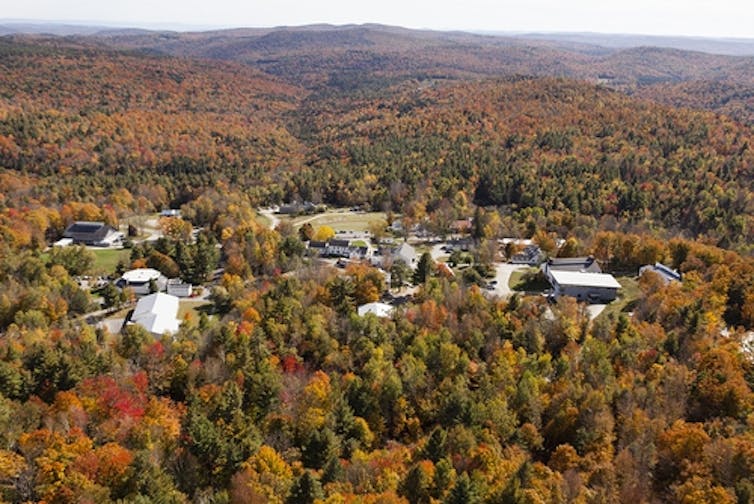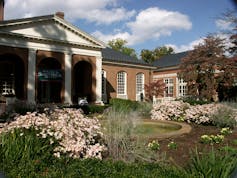At-risk colleges should do what's best for students, alumni, donors, employees – and local communities
- Written by Genevieve Shaker, Associate Professor of Philanthropic Studies, Lilly Family School of Philanthropy, IUPUI
The College of New Rochelle closed in 2019[1], more than a century after its founding as New York’s first Catholic women’s college. The announcement left students scrambling to figure out what to do[2]. The college’s land and buildings were sold for US$32 million[3], most of which paid off debts.
All told, about 90 private and public colleges or universities have closed[4] or merged with other schools since 2016. Reasons for this[5] include declining enrollment, budget shortfalls and growing competition. What’s more, the number of Americans between the ages of 18 and 22[6] is falling, leading to expectations[7] that far more closures and mergers are quite likely to follow[8].
Despite their dire straits, many of these troubled and doomed schools likely will possess significant sums of money and other assets when the end comes. This wealth can include real estate, artwork and philanthropic donations that are invested in endowments[9], or pools of assets that support these institutions.
When colleges get into financial trouble, they can’t always tap that money because of a legal requirement that endowments and donations given for a specific purpose be used in ways that honor what donors intended. This complication can stand in the way when school officials seek to use those assets to remain open or pay for an orderly transition.
Students, alumni, donors, faculty and staff are clearly affected when colleges close. In addition, the communities where these schools are located can lose jobs, tax revenue, population and cultural opportunities.
More closures and worries are coming
We are scholars who have long examined higher education and philanthropy[10]. One of us – William Plater[11] – is a trustee of Antioch University[12], which has grappled with these challenges in recent years.
In 2019, the Department of Education put nearly 500 colleges and universities on a list[13] of schools on a shaky financial footing. Edmit[14], a consulting firm, says that nearly twice as many[15] risk closure for financial reasons. The federal government[16] is growing more concerned about this problem.
This wave of closures is affecting public colleges and universities, too. Government officials and college administrators in Alaska[17], Georgia[18], Wisconsin[19], Connecticut[20], Iowa[21], Arkansas[22] and other states are either already consolidating some of their states’ campuses or considering whether to take that step.
Aftershocks when schools close
Marlboro College[23], a small Vermont school with enrollment that has dwindled to 150[24] students from 350 in 2012, will close at the end of the 2019-2020 school year. It has lost nearly $20 million of its assets since 2015[25] by spending more than it’s taking in.
The college wants to combine with Boston-based Emerson College[26], located 120 miles away. This merger calls for transferring the estimated $30 million that would remain at that point in Marlboro’s endowment plus some $10 million[27] derived from shifting its real estate holdings to Emerson. Marlboro college would close its doors and students could transfer to Emerson, where tuition and housing costs[28] are higher.
The 1,000 residents of Marlboro are pushing back. Town resident and former professor T. Hunter Wilson called the merger and loss of its largest employer “devastating[29],” The Boston Globe reported. Another resident told the paper that he’s worried the closure could cost the town its post office or even its elementary school[30].
 Marlboro College is poised to close soon.
Calebjc, CC BY-SA[31][32]
Marlboro College is poised to close soon.
Calebjc, CC BY-SA[31][32]
The fates of towns and gowns
As colleges struggle to keep the doors open, in our view, they should do more to engage their local communities and funders in their planning processes. This can reduce the impact of sudden disruption[33] that comes to a local community when it has not anticipated closure, as happened in Newton, Massachusetts[34], when Mount Ida College[35] closed in 2018.
Engaging everyone who will be affected by a closure or merger may potentially ease the inevitable pains of transition all around and can result in new facilities and infrastructure that benefit local communities in new ways.
We consider what happened with Marygrove College, a small Catholic institution that first ended its undergraduate programs and then ceased operating its small graduate school in 2019[36], a good example.
Aided by $50 million in funding from the Kresge Foundation[37], the school’s final leaders helped create the Marygrove Conservancy[38]. The college’s 53-acre Detroit campus was deeded to the new entity, which will house an educational program[39] including an early childhood center, a K-12 school operated by the local public school system and a teacher training program.
This arrangement aligns with the values of the Catholic sisters who founded Marygrove College in 1905. It was possible only because school leaders gave their students, alumni, communities and donors plenty of time to forge a plan for a different future than they expected.
We realize that this kind of transformation isn’t always possible. Regardless, what we consider to be Marygrove’s promising future shows why all colleges should be as open as they can when they get into financial trouble.
 Many of now-closed Marygrove College’s buildings will serve a new purpose.
Dwight Burdette, CC BY-SA[40][41]
Many of now-closed Marygrove College’s buildings will serve a new purpose.
Dwight Burdette, CC BY-SA[40][41]
Deciding what to do with the money
In these circumstances, control of remaining assets is usually determined by the concept of “cy près[42],” a British common law term drawn from the French for “as near as possible.” It means that a court can redirect property, including endowments and land, from colleges and other nonprofits to a charitable purpose that is similar to the original intent of the donors when they chose to support those institutions.
In real life, these things get pretty messy. Consider what happened when Chester College of New England[43], a now-defunct liberal arts college in New Hampshire, folded in 2012. It initially expected most of its remaining students to attend New England College, another school in the state. It promised that school its remaining assets as an effort to honor the intents of Chester’s donors.
When most of the displaced students enrolled instead at the New Hampshire Institute of Art, that school objected. Ultimately the court split the funds[44] between the two schools. But the Institute itself has since closed[45]. It will become part of New England College[46].
The legal principle of cy près can complicate matters for colleges that are struggling to keep their doors open. They are bound by law to try their best to honor the wishes of their current and past donors, limiting what they do in emergencies.
 Sweet Briar is bouncing back from financial woes.
Annette Teng, CC BY-ND[47][48]
Sweet Briar is bouncing back from financial woes.
Annette Teng, CC BY-ND[47][48]
Sweet Briar
This legal principle may have helped save Sweet Briar[49], a women’s college in the small town of Amherst, Virginia. In 2015, the college’s president and trustees were convinced at the time that the institution could not overcome its enrollment and financial management difficulties, despite its $65 million endowment. The mayor of Amherst[50] urged the school’s leaders to reconsider in a letter that emphasized the damage that closure would cause the local community.
Many of its graduates sued[51] to prevent the closing, as did members of the faculty[52] and the local county government[53]. The alumni then went on to raise enough money[54] to rescue the school.
But prior to that rescue, Sweet Briar College ran into a different kind of trouble. When it sought to sell some of its assets, a judge blocked the sale[55] for being at odds with the directions of Indiana Fletcher Williams[56], whose bequest led to the institution’s founding in 1901.
Happily, the college has now raised a total of $63.9 million[57]. By many accounts[58], it’s on the road to what could prove a complete recovery.
[ You’re too busy to read everything. We get it. That’s why we’ve got a weekly newsletter. Sign up for good Sunday reading.[59] ]
References
- ^ closed in 2019 (www.cny.org)
- ^ scrambling to figure out what to do (newyork.cbslocal.com)
- ^ were sold for US$32 million (dailyvoice.com)
- ^ universities have closed (www.educationdive.com)
- ^ Reasons for this (theconversation.com)
- ^ between the ages of 18 and 22 (factfinder.census.gov)
- ^ expectations (www.educationdive.com)
- ^ far more closures and mergers are quite likely to follow (hechingerreport.org)
- ^ invested in endowments (theconversation.com)
- ^ higher education and philanthropy (www.researchgate.net)
- ^ William Plater (scholar.google.com)
- ^ Antioch University (www.insidehighered.com)
- ^ nearly 500 colleges and universities on a list (studentaid.ed.gov)
- ^ Edmit (www.edmit.me)
- ^ twice as many (www.insidehighered.com)
- ^ federal government (www.usnews.com)
- ^ Alaska (www.ktuu.com)
- ^ Georgia (consolidation.gsu.edu)
- ^ Wisconsin (www.jsonline.com)
- ^ Connecticut (ctmirror.org)
- ^ Iowa (www.desmoinesregister.com)
- ^ Arkansas (www.nwaonline.com)
- ^ Marlboro College (www.marlboro.edu)
- ^ enrollment that has dwindled to 150 (www.marlboro.edu)
- ^ lost nearly $20 million of its assets since 2015 (berkeleybeacon.com)
- ^ Boston-based Emerson College (www.marlboro.edu)
- ^ endowment plus some $10 million (www.educationdive.com)
- ^ housing costs (berkeleybeacon.com)
- ^ devastating (www.boston.com)
- ^ elementary school (theconversation.com)
- ^ Calebjc (upload.wikimedia.org)
- ^ CC BY-SA (creativecommons.org)
- ^ sudden disruption (hechingerreport.org)
- ^ Newton, Massachusetts (www.educationdive.com)
- ^ Mount Ida College (www.wbur.org)
- ^ ceased operating its small graduate school in 2019 (www.wxyz.com)
- ^ Kresge Foundation (www.ihep.org)
- ^ Marygrove Conservancy (www.freep.com)
- ^ educational program (detroit.curbed.com)
- ^ Dwight Burdette (commons.wikimedia.org)
- ^ CC BY-SA (creativecommons.org)
- ^ cy près (www.law.cornell.edu)
- ^ Chester College of New England (www.eagletribune.com)
- ^ court split the funds (nonprofitquarterly.org)
- ^ Institute itself has since closed (www.mass.edu)
- ^ become part of New England College (www.concordmonitor.com)
- ^ Annette Teng (web.archive.org)
- ^ CC BY-ND (creativecommons.org)
- ^ Sweet Briar (www.philanthropy.com)
- ^ mayor of Amherst (www.americaninno.com)
- ^ graduates sued (scholarship.richmond.edu)
- ^ members of the faculty (www.whsv.com)
- ^ local county government (wset.com)
- ^ raise enough money (www.philanthropy.com)
- ^ a judge blocked the sale (www.richmond.com)
- ^ Indiana Fletcher Williams (sbc.edu)
- ^ raised a total of $63.9 million (www.newsadvance.com)
- ^ many accounts (www.roanoke.com)
- ^ Sign up for good Sunday reading. (theconversation.com)
Authors: Genevieve Shaker, Associate Professor of Philanthropic Studies, Lilly Family School of Philanthropy, IUPUI

